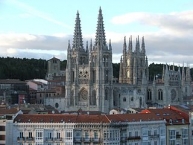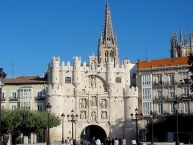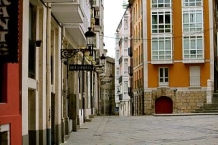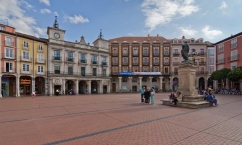Cycle Tour Burgos - Bilbao
Planned tour
Actions
![]()
Please wait - map data are loading
Added on 07 Nov 2019,
last edited by biroto-Redaktion on 07 Nov 2019
Actions
Cycle route metrics
planned
ridden
Total distance in km
204
0
Cumulative elevation gain in m
2.190
0
Avg. slope uphill in %
1,07
-
Cumulative elevation loss in m
3.054
0
Information about rights to the gps-track data | |
|---|---|
Rights owner | |
Rights characteristic / license | cc0: Public Domain no Rights reserved |
Link to the description of the license | |
GPX file uploaded | by biroto-Redaktion on 07 Nov 2019
|
Track points in total
2.798
0
Track points per km (avg)
14
0
Start/endpoint
Start location
Burgos, Castile and León, ES (877 m NHN)
End location
Bilbao, Basque Country, ES (13 m NHN)
Beds4Cyclists, worth visiting and infrastructure
Name and address
Latitude / Longitude
Phone
Fax
Mobile
Type of accommodation
Rating for cyclists
Route km
Dist. to route
Elevation
0 km
0,6 km
876 m
Information about copyright | |
|---|---|
Rights owner | commons.wikimedia.org/w/index.php?title=User:Camino_del_Cid._Patricia_Ansótegui&action=e |
Rights characteristic / license | by-sa: CREATIVE COMMONS Attribution-ShareAlike |
Link to the description of the license | |
Image taken over from | |
Image has been uploaded | by biroto-Redaktion on 29 Oct 2012
|
Information about copyright | |
|---|---|
Rights owner | |
Rights characteristic / license | cc0: Public Domain no Rights reserved |
Link to the description of the license | |
Image taken over from | commons.wikimedia.org/wiki/File:Burgos_-_Arco_de_Santa_Maria_28.JPG |
Image has been uploaded | by biroto-Redaktion on 15 Mar 2015
|
Information about copyright | |
|---|---|
Rights owner | Jared L. Stahl |
Rights characteristic / license | by: CREATIVE COMMONS Attribution |
Link to the description of the license | |
Image taken over from | en.wikipedia.org/wiki/File:Burgos_Historic_Centre_near_the_cathedral.jpg |
Image has been uploaded | by biroto-Redaktion on 29 Oct 2012
|
Information about copyright | |
|---|---|
Rights owner | |
Rights characteristic / license | by-sa: CREATIVE COMMONS Attribution-ShareAlike |
Link to the description of the license | |
Image taken over from | commons.wikimedia.org/wiki/File:Plaza_Mayor_de_Burgos_-_01.jpg |
Image has been uploaded | by biroto-Redaktion on 15 Mar 2015
|
Burgos ([ˈburɣos]) is a city in northern Spain, historic capital of Castile. It is situated on the confluence of the Arlanzón river tributaries, at the edge of the Iberian central plateau. It has about 180,000 inhabitants in the actual city and another 20,000 in the metropolitan area. It is the capital of the province of Burgos, in the autonomous community of Castile and León. The Burgos Laws or Leyes de Burgos which first governed the behaviour of Spaniards towards the natives of the Americas were promulgated here in 1512.
See
It has many historic landmarks, of particular importance; the ⊙Cathedral of Burgos ![]() (declared World Heritage Site by UNESCO in 1984) and the Cartuja of Miraflores. A large number of churches, palaces and other buildings from themedieval age remain. The city is surrounded by the Fuentes Blancas and the Paseo de la Isla parks.
(declared World Heritage Site by UNESCO in 1984) and the Cartuja of Miraflores. A large number of churches, palaces and other buildings from themedieval age remain. The city is surrounded by the Fuentes Blancas and the Paseo de la Isla parks.
The city forms the principal crossroad of northern Spain along the Camino de Santiago, which runs parallel to the River Arlanzón.
Religious architecture
Burgos is rich in ancient churches and convents. The three most notable are the cathedral, with its chapel of the Condestables de Castilla, the monastery of Las Huelgas, and the Carthusian monastery of Miraflores (3 km outside). Minor notable churches are San Esteban, San Gil (Sancti Aegidii), San Pedro, San Cosme y San Damián, Santiago (Sancti Jacobi), San Lorenzo and San Lesmes (Adelelmi). The Convento de la Merced, occupied by the Jesuits, and the Hospital del Rey are also of historic and architectural interest.
- ⊙Burgos' Gothic Cathedral

Construction on Burgos' Gothic Cathedral began in 1221 and spanned mainly from the 13th to 15th centuries. It has been declared a UNESCO World Heritage Site. The west front is flanked by towers terminating in octagonal spires covered with open stonework traceries. The middle section, which serves as an entrance, has three alabaster pilasters, the intercolumnar spaces bearing panel-pictures representing the martyrdom of saints. The façade possessed ornate and fantastic surface decoration.
The octagonal chapel of the Condestable, in florid, thus highly sculpted, Gothic design, has a roof finished with balustraded turrets, needle-pointed pinnacles, and statues. In the lower portion, coats of arms, shields, and crouching lions have been worked into the ensemble. The exterior of the sacristy is decorated with carved traceries, figures of angels and armoured knights. The elaborate tabernacle is composed of two octagonal sections in Corinthian style.
Open: daily 10:00-18:00. - ⊙Monasterio de las Huelgas Reales
The Monastery of the Royal Retreats on the outskirts of the city, was founded in 1180 by king Alfonso VIII, and was begun in a pre-Gothic style, although almost every style has been introduced over many additions. The remarkable cloisters have been described as "unrivalled for beauty both of detail and design, and perhaps unsurpassed by anything in its age and style in any part of Europe" (1911 Encyclopædia Britannica). One cloister has semicircular arches with delicate and varied columns; the other has an ogival style of early Gothic. The interior of the church has enormous columns supporting its magnificent vault; the entrance is modern. This convent historically benefited from extraordinary privileges granted to its abbess by kings and popes.
- ⊙Iglesia de San Gil Abad
After the cathedral, it is considered the best example of Gothic in the city Gothic in style, it was possibly built over the hermitage of San Bartolomé that existed towards the end of the 13th century. It has a structure in three naves with a transept and side chapels, among which the Good Morning chapel stands out, with a Gothic altarpiece from the end of the 15th century, the work of Gil de Siloé; the Chapel of the Kings, with a Renaissance altarpiece attributed to the latter; and the funerary chapel of the Nativity, added in the 16th century and attributed to Juan de Matienzo. The chapel of the Holy Christ was added in the 16th century by the Burgos architect Juan de Vallejo. Finally, on the sides of the temple, is the Texada arch, which allowed the passage of large merchandise wagons from the Cantabrian ports. - ⊙Iglesia de San Esteban - Altarpiece Museum
Gothic in style, the current temple was built on top of an ancient Roman temple at the end of the 13th century and during the first half of the 14th century. For decades this church has not been worshiped (transferred to the nearby church of San Nicolás de Bari) and is the well-known Altarpiece Museum. - ⊙Iglesia de San Nicolás de Bari
Located in front of the main facade of the cathedral. It was built in 1408 on top of another Romanesque temple. It is presided over by one of the most impressive and monumental altarpieces of Spanish Renaissance Art, made in the 15th century in Simón de Colonia's workshop, designed by him and made by his son Francisco. Also of great interest are its Gothic tombs, the Renaissance arch of María Sáez de Oña and Fernando de Mena and the tables of the Burgos School of the Master of San Nicolás. - ⊙Iglesia de La Merced
Jesuit Church in the city, recently restored Late Gothic monument from the 15th and 16th centuries located on Calle de la Merced. Today it continues to have a religious use as a parish for the Jesuit priests, while the old convent premises, inhabited by the Mercedarians for more than three centuries, are today integrated into a hotel business. - ⊙Iglesia de San Cosme y San Damián
Building built in the 16th century halfway between Gothic and Renaissance. The cover of Juan de Vallejo stands out, as well as several altarpieces and for being the burial place of prominent Burgos artists of the time. - ⊙Iglesia de San Lesmes
It is a Gothic church located on the Camino de Santiago. It was ordered to be built by Alfonso V.
Other Buildings
The city preserves its medievalhistoric centre, corresponding to the city walls. Among the other interesting architectural structures, in the walls of the city are the famous gateway of Santa María, erected for the first entrance of the Emperor Charles V, and the arch of Fernán González.
- ⊙ Arco de Santa María
 .
.
It is one of the old twelve access gates to the city in the Middle Ages, rebuilt as an arch in honor of Carlos I of Spain. It connects the Santa María bridge, over the Arlanzón river, with the San Fernando square, where the cathedral stands. - ⊙Burgos Castle
It is located on the hill of its name elevated to 75 m above the level of the city. It was ordered to be erected by Count Diego Porcelos at the time of the Reconquest, in the year 884, and under the mandate of Alfonso III. The defensive building became a great royal fortress and a place of prison, and a place of lodging for nobles. The final construction of the castle took place towards the end of the 15th century or the beginning of the 16th century. In 1813, Napoleon's soldiers blew it up shortly before leaving the city. Frontal view of the Capitanía building, in the historic center of the city. - ⊙Palacio de Capitanía General
It served as a military base during the uprising of the civil war. From him, Franco was declared Superior Commander of the Armies of Spain. Although the building is currently in disuse, in the future it will house offices of the Defense sub-delegation in the city. View of the Palace of Castilfalé, currently the seat of the Municipal Archive of the city. - ⊙Palacio de Castilfalé
In front of the door of the Coronería of the cathedral, the house of Los Colonia was built in the second half of the 15th century. On the site of the same, Juan Vallejo began the construction of a palace acquired in 1565 by Andrés de Maluenda. Although the building, made of stone and brick, as was customary in Burgos domestic architecture, was transformed by its successive owners; the last, in the 20th century, was the count of Castilfalé. It was the occasional residence of personalities such as King Ferdinand VII and Napoleon Bonaparte. Ceded by its last owners, the counts of Castilfalé, to the Burgos City Council in 1969, it was restored and rehabilitated as the Municipal Archive, in 1985. - ⊙Palacio de los Condestables de Castilla
Also known as the Casa del Cordón, it is an old Renaissance palace from the 15th century that stands in the historic center of Burgos. Its promoter was the Constable of Castilla Pedro Fernández de Velasco. The initial design is attributable to Juan de Colonia and his son Simón and it is a civil building in the late Gothic style. As confirmed by an inscription on its façade, the building received Christopher Columbus after his second voyage to the Americas. - ⊙Palacio de la Isla
It was built in 1883. It was the residence of the Head of State during the civil war between 1936 and 1939. It has had numerous functions until it became the official headquarters of the |Instituto de la Lengua de Castilla y León. From him the order was given to end the Civil War. It also has the first elevator that was installed in the Community. - ⊙Casa de Miranda
In its dependencies is the provincial museum, former Archaeological Museum, which stands in two adjoining palaces from the 16th century. The patio of Casa de Miranda stands out with its supported galleries. - ⊙Casa de Íñigo Angulo
Located next to the Burgos Museum, a complex of which it is a part. It is one of the best examples of the Burgos renaissance, built by Juan de Vallejo in 1547. The main doorway is topped by a large shield with the arms of the 18th century owners, from whom it receives its name. Next to it is the Melgosa house, which will also house the extension of the provincial museum in the future. - ⊙Consulado del Mar
It is a neoclassical building, designed by Manuel Eraso in 1796 and located on Paseo del Espolón. It was the headquarters of groups of merchants from Burgos during the Modern Age to charter ships from the Cantabrian ports to those of Flanders. Later it housed the Royal Provincial Academy of Drawing, and currently has an exhibition hall. - ⊙Hospital del Rey
Located next to the Camino de Santiago as it passes through Burgos, in the west of the city. It was founded by Alfonso VIII in 1195. Dependent on the Monastery of Santa María la Real de Las Huelgas, it was a great center for receiving pilgrims. In the 15th century it had 87 beds, being one of the most important hospitals on the entire Jacobean route. Currently, it houses the headquarters of the law school and the rectory of the university. - ⊙Hospital de la Concepción
Old hospital located in the south of the city. In Renaissance style, its construction began in the 16th century. It housed the city's Medical School for over a hundred years. It currently belongs to the University.
Museums
- The ⊙Museum of Human Evolution
was opened in 2010, unique in its kind across the world and projected to become one of the top 10 most-visited museums in Spain. The museum features the first Europeans, which lived in this area 800,000 years ago.
- The ⊙Museum of Burgos summarizes the history of the province of Burgos. It has important objects and documents from all the ages, starting from Atapuerca, passing to the Romans and Iberians, and finishing in the contemporary period. The museum is located in a renascence palace, the House of Íñigo Angulo, which has a main patio that structures the museum.
Information about copyright | |
|---|---|
Rights characteristic / license | by-sa: CREATIVE COMMONS Attribution-ShareAlike |
Link to the description of the license | |
Input taken over from: |
|
taken over / edited on | 29 Oct 2012 - 08 Dec 2022
|
taken over / edited by |
|
0 km
0,5 km
876 m
0 km
0,7 km
883 m
0 km
0,9 km
878 m
0 km
0,7 km
875 m
![]()




